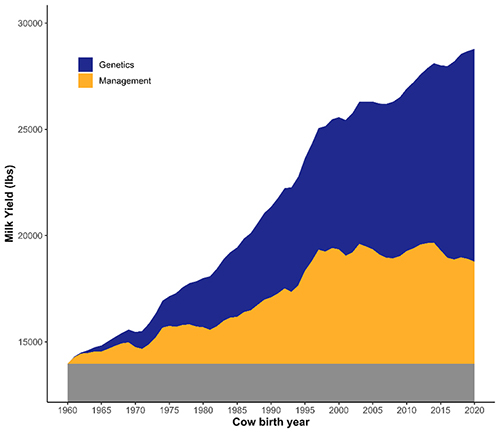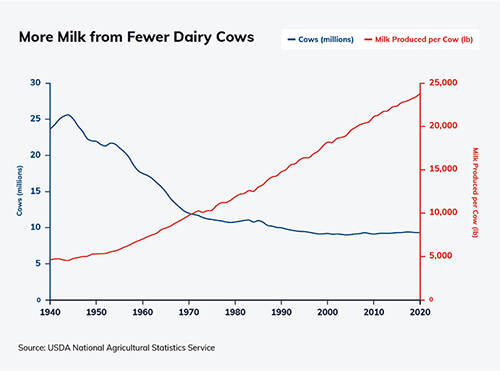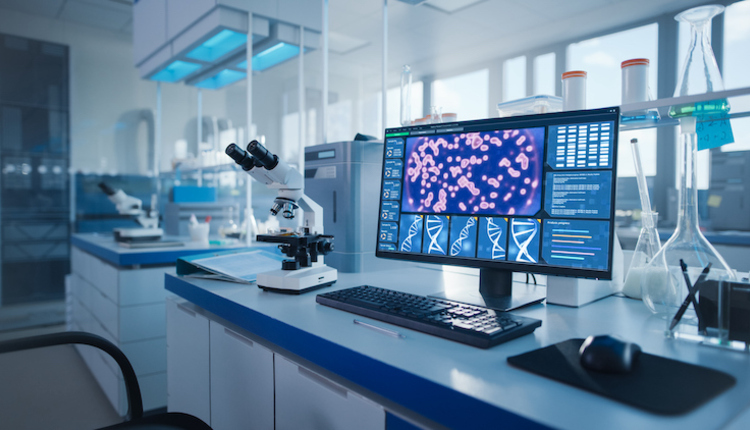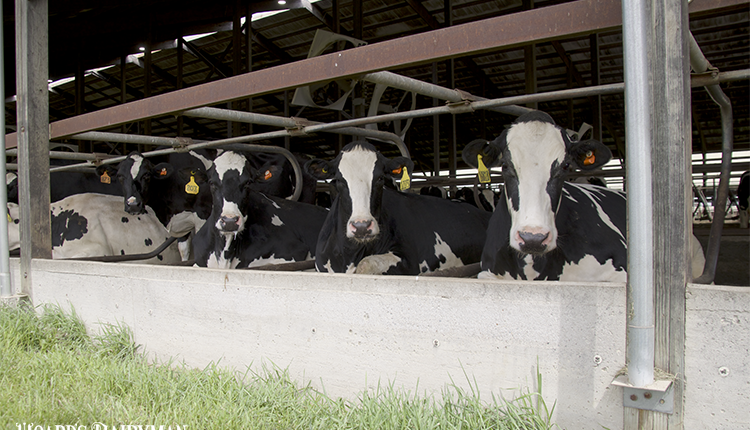
The U.S. dairy community has rallied around a public commitment to achieve carbon neutrality, optimize water usage, and improve water quality by 2050 — supporting global sustainability initiatives and customer expectations. Genetic selection is one part of the equation that will enable U.S. dairy farms and processors to collectively achieve this lofty goal.
How precisely do genetics impact sustainability both now and into the future?
Genetic selection is an important tool to reduce dairy’s carbon footprint. This impact ranges from the improved productivity of U.S. dairy cows over several decades to the relatively new ability to genetically select for cows that use feed more efficiently while producing the same amount of milk. This begs the question: What other aspects of sustainability — such as animal well-being and methane emissions — can be addressed through genetics?
An in-person discussion
We will explore these questions during the upcoming CDCB Industry Meeting on October 5 during World Dairy Expo in Madison, Wis. Through panels and future-focused updates, dairy producers, customers, and geneticists will share perspective on sustainability expectations and the genetic contribution. Headlining the program will be four dairy producers from four states — Marilyn Hershey from Pennsylvania, Lloyd Holterman from Wisconsin, Mike McCloskey from Indiana, and Bill Peck from New York. The agenda provides ample opportunity for an open dialogue between attendees and these respected panelists.
Genetic gains, improved dairy efficiency
It’s well-known that U.S. dairy cows today are producing four times more milk than they did in 1945 and twice as much versus 1970 due to advancements in both management and genetics. From a peak of 27.8 million dairy cows in 1945, the U.S. herd shrunk to 9.4 million in 2021. The resulting gains in milk production from far fewer cows has significantly reduced the use of inputs, land, water, and other natural resources.
What proportion of this productivity increase can we attribute to genetic improvement?
While there are several ways to analyze and answer this question, here’s a simple response: More than one-half of the gains come through genetics.
More specifically, let’s look at fat and protein yield. The gains in total fat plus protein for cows on Dairy Herd Information Association (DHIA) since 1970 are shown in Table 1, along with amount and percentage of gain due to genetics. Genetic improvement has accounted for 62% of the fat plus protein production increase in the U.S. dairy herds since 1970.
Table 1: Total and genetic increases in fat plus protein for U.S. Holsteins* within each decade

Another way to look at this is through milk yield. The chart below shows the average annual milk yield per U.S. Holstein cow in DHI herds. That data shows an improvement in the last six decades from about 13,000 to 28,000 pounds of milk. The yellowish-orange area shows the gain due to improved management, while the blue shows the gains through genetic potential.

Certainly, management and genetics work hand-in-hand. As we make genetic progress, the complementary improvements in cow nutrition and management allow us to realize more of that genetic potential.
Beyond efficiency
In the early years, genetic selection focused on raising milk, fat, and protein yield. Since 1994, the U.S. has developed traits to genetically select for longevity, somatic cell score, fertility, disease resistance, and feed efficiency
Our ability to breed for improved animal health, fertility and longevity directly support the public and dairy customer interest to continuously improve animal welfare — another part of sustainability.
CDCB and collaborating researchers continue to identify new genetic tools for producers to improve cow health, and updates to this work will be shared during our October 5 meeting. With the August triannual evaluations, CDCB health traits were expanded to the Brown Swiss breed. Evaluations for resistance to six common disorders — displaced abomasum, hypocalcemia, ketosis, mastitis, metritis, and retained placenta — are available for Holstein animals (since 2018), Jerseys (since 2020), and Brown Swiss. We are currently evaluating genetic resistance to Johne’s disease as a new trait.
Lameness is another important topic for animal well-being, with estimates that about one-half of U.S. dairy cows will be affected by lameness during their productive life. CDCB, the University of Minnesota, and several collaborators are working to create a pipeline for hoof health data collection and better understand genetic improvement for cow mobility. These are essential steps for CDCB to develop genetic selection tools and improvement management tools for lameness.
In 2020, the ability to genetically select for feed efficiency became a reality through the traits of Feed Saved and Residual Feed Intake. Feed efficiency traits are a ‘win-win’ for producers seeking cost control, and for dairy customers who expect sustainably produced milk and dairy products. By leveraging animals’ genetic ability to make the same amount of milk with less feed, fewer natural resources are needed to produce feedstuffs and dairy’s greenhouse gas footprint is reduced.
Join the October 5 CDCB Meeting
All dairy producers, industry professionals, and genetic enthusiasts are invited to join this discussion on Wednesday, October 5, from 8 a.m. to 12 p.m. in the Exhibition Hall (Mendota 2) on the World Dairy Expo grounds. Registration is appreciated for appropriate planning; RSVP here. There is no fee to attend, and walk-ins are welcome on the meeting day.









